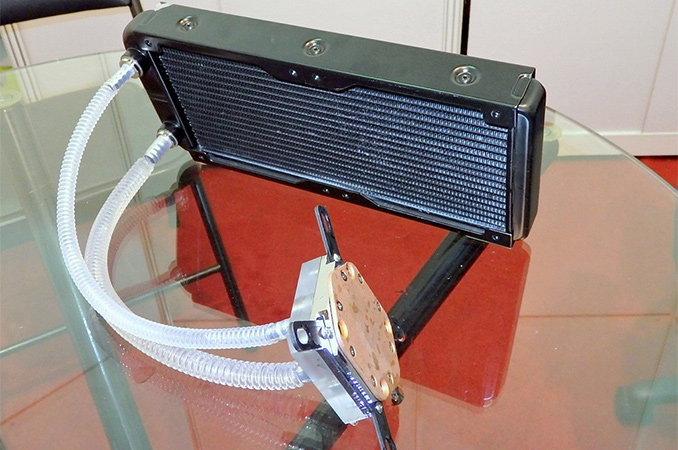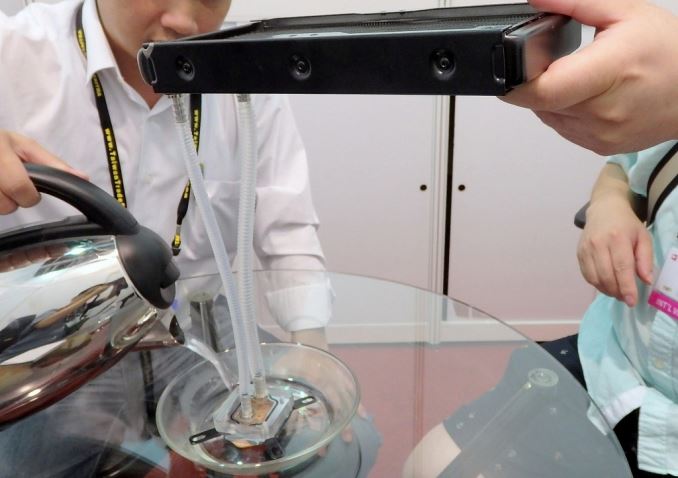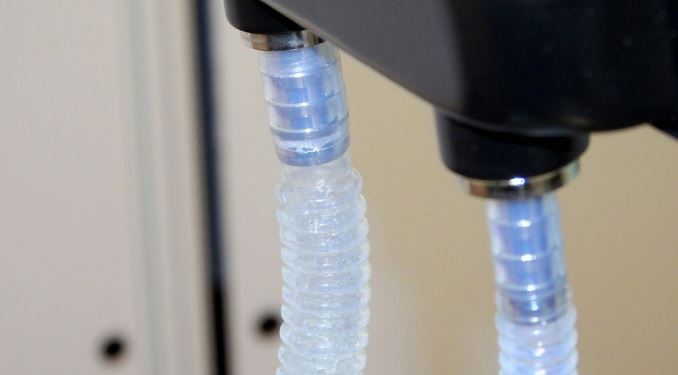Raijintek Shows Off Pumpless Liquid Cooling System
by Anton Shilov on June 3, 2016 10:00 AM EST
In the recent year’s all-in-one liquid cooling solutions gained significant popularity thanks to efficiency and quieter operation. However, even with those improvements, a closed loop cooler still needs a pump to enable circulation of liquid as well as at least one fan to maximize cooling efficiency. Seen as the next step, pumpless liquid cooling systems have been discussed by various developers for a while, and Raijintek demonstrated one at Computex 2016.
The prototype of Raijintek’s pumpless liquid cooling system is comprised of a completely passive CPU/GPU water block with a copper base (featuring a system of very thin channels to maximize heat dissipating surface area) with two nozzles of different diameter, two tubes as well as a radiator (images are by Hermitage Akihabara). The LCS is filled with a customized coolant, which has evaporation point of around 40°C to 50°C. Once the CPU or the GPU gets hot enough, the coolant turns into vapor and streams to the radiator through one of the tubes where it condenses back to liquid, whereas the cool coolant streams back to the water block.
Raijintek's prototype of a pumpless LCS. Image by Hermitage Akihabara.
Natural processes enable the circulation and the liquid cooling system is nearly noiseless (keep in mind that physical processes like water circulation create noises). In the best-case scenario, the higher is the temperature of the chip cooled down by such a LCS, the faster is the circulation. The theoretical limit of TDP that Raijintek’s prototype can handle is unclear, but different reports point to over 200 W, which is in line with traditional high-end and AIO liquid coolers. At Computex, the manufacturer demonstrated the prototype without any fans, but the radiator can be equipped with two of them to maximize cooling performance. While fans are not compulsory, there is a requirement, though: the radiator always has to be installed above the water block, which is something harder to do in small form-factor PCs.
Raijintek's prototype of a pumpless LCS. Image by Hermitage Akihabara.
The advantages of pumpless LCS are obvious: it does not have moving parts and therefore is more reliable than traditional systems; it does not generate as much noise and does not use power, provided that the coolant is cheap enough, the cost of a pumpless LCS should be lower than the cost of a traditional closed-loop liquid cooling system. On the other hand, it is completely unclear how the liquid with a very low evaporation point handles high TDPs when placed in a hot external environment. Besides, temperature of such liquid should remain below 40°C at all times (so, you are not going to use such device in Qatar, where temperatures above 40°C are common). Finally, the LCS must be perfectly sealed to maintain vacuum inside because any slight imbalance of pressure inside will harm its operation, a requirement that potentially increases the cost of the device.
Raijintek's prototype of a pumpless LCS. Image by Hermitage Akihabara.
Raijintek has invested a lot in development of its pumpless LCS over the years. In fact, the first prototype was ready back last year, but the company decided not to demonstrate it, but patent the technology in major markets first. Given the price of the new coolant as well as a new manufacturing process required to build pumpless LCS with vacuum inside, the price of the final product will not be low and may be actually higher compared to traditional AIO liquid coolers.
It is interesting to note that Raijintek is not the first to showcase a pumpless closed-loop liquid cooling system. Back in 2014, Silverstone demonstrated its prototype at Computex, but so far the company has not released it commercially.
Sources: BitTech, Hermitage Akihabara, TechPowerUp, 3DNews.













65 Comments
View All Comments
rahvin - Friday, June 3, 2016 - link
There is absolutely no question that air cooling will always be cheaper. But there should be no circumstance, even with the worst failing pump imaginable where the water cooling system is going to be noisier than fans. If that has occurred then someone didn't know what they were doing. Pumps sold these days have decibel ratings in the low teens, often 5 to 10 decibels lower than even the most silent fans. In addition water cooling allows you to overclock while still maintaining those low noise thresholds.My water cooled system is in the living room and it's quieter than the fans on the TV. Yes if the room is perfectly silent you can hear the pump and the water entering the reservoir (light splashing sound) but any other sound, including conversation overwhelms it.
DanNeely - Friday, June 3, 2016 - link
Pump noise is also a major factor of how fast the pump is going. I've got a 35X series pump (not sure exactly which one -swiftechs 2012 or 2013 model probably). At its stock speed of 4500 RPM it's annoyingly whiny. Adjusted down via fan controller to ~3k RPM it's inaudible with my case shut; and only costs 1 or 2C in terms of higher CPU temps.maximumGPU - Saturday, June 4, 2016 - link
But you're using fans on your WC loop as well. Granted you can lower their rpm for the same delta T temperature compared to an air cooled solution, but with the best air coolers you can sacrifice a few degrees and have the same delta T minus the additional pump noise. I don't exactly see how WC would be quieter.Death666Angel - Saturday, June 4, 2016 - link
"I don't exactly see how WC would be quieter."How much time have you invested into WC research?
http://www.frozencpu.com/products/19811/ex-rad-599...
http://koolance.com/radiator-9-fan-120mm-18-fpi-al...
9x1x0mm radiators have so much more cooling area compared to CPU and GPU heatsinks, meaning of course they will be quieter.
I'm personally not using one of those, because I wanted my desktop to still be semi-mobile without too much hassle. But I have a 4x120mm radiator and a 200mm one. The 4x120mm one is outside screwed to one side of the mATX case and the 200mm one is located in the front with the 200mm fan. It transports most of the heat out of the case and the little amount of heat that is inside gets pushed through while providing some cooling to the internal components (RAM, VRMs etc.). It is much quieter than any air cooling solutions I had, while providing lower temps for my CPU and GPU, which means higher overclocks and lower power consumption. But it is only useful if you are interested in the building and maintenance side of things. Otherwise, air cooling provides adequate enough performance for the price and time investment.
Spunjji - Saturday, June 4, 2016 - link
"Anyone that suggests air cooling is better than water cooling for noise has never actually heard a water cooled computer."Chipping in as someone who has extensively built both types of system aimed towards silence, that's not true.
Here's another way to look at it: A computer using only 2x ~120mm fans (1 CPU fan, 1 exhaust, passive GPU) and no spinning hard disks has two noise sources: those 2 fans. With wide-fin coolers those do not encounter much back-pressure, so they spin slowly with minimal turbulence. The system is not silent but it is very, very quiet.
Meanwhile, the very same system with a water-cooling unit may be able to throw out a fan (exhaust and CPU fan are now one and the same) but has added a new source of direct and indirect noise - the pump and the vibrations it generates. Even if these are minimal, that's still an extra 2 frequencies of sound to deal with. The fan also experiences far greater back-pressure so its speed has to be raised higher to generate sufficient static pressure to cool well.
I have built very quiet computers with water cooling but my quietest systems are /always/ air cooled. There's just fewer noise sources to deal with and those that exist are much more benevolent.
Death666Angel - Saturday, June 4, 2016 - link
Decouple your pump from the case and you have no to hardly any vibrations from the pump. And you are misleading when you say you replace 2x120mm aircooler with 1x120mm fan/radiator. Seems like you are only talking about CPU watercooling and maybe AIOs. That's not what most custom made water cooler setups look like. The least people go for is 280mm radiators, which already has more surface area than most CPU heatsinks and can even do CPU + GPU when you don't want to go super quiet. If you go to 480mm or 2x2x0 etc. you can get even more surface area compared to CPU/GPU heatsinks, thus lowering the fan RPMs you need to get the same results. The potential for water cooling to be quiet and powerful is always greater than air cooling. If people reach that potential is up to them, their wallet and their time investment.Alexvrb - Saturday, June 4, 2016 - link
As someone who has dealt with fanless lower power systems at work... use fans for airflow. If you get a set of high-end Noctuas or similar and use the low power adapter and/or PWM profiles, they're dead silent, and for that pumpless liquid cooler to dissipate a lot of watts it still needs airflow!!I would tend to agree this is good for a GPU though. The only way I'd use it on a CPU (especially an overclocked one) is probably with a peltier.
djayjp - Friday, June 3, 2016 - link
"...thanks to efficiency and quieter operation...". Actually the best air coolers exhibit better temperature/noise efficiency performance than the best AIO water coolers. Really surprised an author of AT doesn't know better....ShieTar - Friday, June 3, 2016 - link
For normal setups yes, but for more excessive CPU overclocking, All-in-One with two radiators is sometimes quieter than the big tower coolers.Arnulf - Friday, June 3, 2016 - link
This is not "liquid cooling", this is "phase change cooling" and has about as much to do with "liquid cooling" (such as that used in power transformers, high power tubes etc.), .as my refrigirator does.